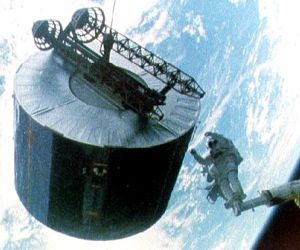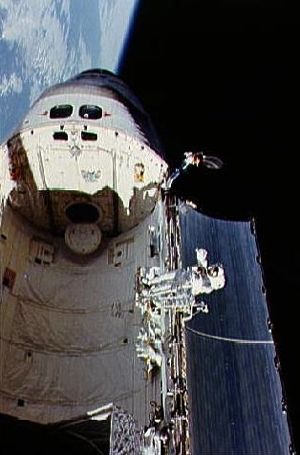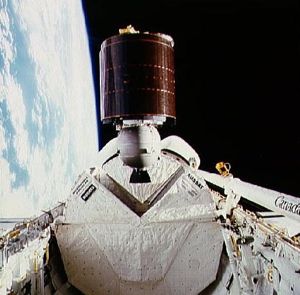
Home - Search - Browse - Alphabetic Index: 0- 1- 2- 3- 4- 5- 6- 7- 8- 9
A- B- C- D- E- F- G- H- I- J- K- L- M- N- O- P- Q- R- S- T- U- V- W- X- Y- Z
STS-51-I

STS-51-I
Aerial view of the launch of Shuttle Discovery STS 51-I mission
Credit: NASA
AKA: Discovery. Launched: 1985-08-27. Returned: 1985-09-03. Number crew: 5 . Duration: 7.10 days.
Payloads: Deploy ASC (American Satellite Company)-1 with Payload Assist Module (PAM)-D. Deploy AUSSAT (Australian communications satellite)-1 with PAM-D. Deploy Syncom IV-4 communications satellite with its unique stage. Retrieve Leasat-3 communications satellite, repair and deploy by extravehicular activity (EVA) astronauts. Physical Vapor Transport Organic Solids (PVTOS) experiment.
Orbits of Earth: 111. Distance traveled: 4,698,602 km. Orbiter Liftoff Mass: 118,981 kg. Orbiter Mass at Landing: 89,208 kg. Payload to Orbit: 19,952 kg. Payload Returned: 6,101 kg. Landed at: Runway 23 dry lake bed at Edwards Air Force Base, . Landing Speed: 353 kph. Touchdown miss distance: 640 m. Landing Rollout: 1,859 m. EVA: James van Hoften and William Fisher. EVA 1 duration 7 hours, 20 minutes, EVA 2 duration 4 hours, 31 minutes.
NASA Official Mission Narrative
Mission Name: 51-I (20)
DISCOVERY (6)
Pad 39-A (32)
20th Shuttle mission
6th Flight OV-103
Shortened mission
Crew:
Joseph H. Engle (2), Commander
Richard O. Covey (1), Pilot
James D. A. van Hoften (2), Mission Specialist 1
John M. Lounge (1), Mission Specialist 2
William F. Fisher (1), Mission Specialist 3
Milestones:
OPF - June 29, 1985
VAB - July 30, 1985
PAD - Aug. 6, 1985
Payload:
ASC-1,AUSSAT-1,LEASAT-4,PVTOS
Mission Objectives:
Launch:
August 27, 1985, 6:58:01 a.m. EDT. Launch Aug. 24 scrubbed at T-5 minutes due to thunderstorms in vicinity. Launch Aug. 25 delayed when orbiter's number five on-board general purpose computer failed. Launch Aug. 27 delayed three minutes, one second due to combination of weather and unauthorized ship entering restricted solid rocket booster recovery area. Launch Weight: 262,309 lbs.
Orbit:
Altitude: 242nm
Inclination: 28.45 degrees
Orbits: 112
Duration: 7 days, 2 hours, 17 minutes, 42 seconds.
Distance: 2,919,576 miles
Hardware:
SRB: BI-020
SRM: L020(HPM)
ET : 21/LWT-14
MLP : 1
SSME-1: SN-2109
SSME-2: SN-2018
SSME-3: SN-2012
Landing:
September 3, 1985, 6:15:43 a.m. PDT, Runway 23, Edwards Air Force Base, Calif. Rollout distance: 6,100 feet. Rollout time: 47 seconds. Mission shortened one day when AUSSAT sunshield hung up on remote manipulator system camera and AUSSAT had to be deployed before scheduled. Orbiter returned to KSC Sept. 8, 1985. Landing Weight: 196,674 lbs.
Mission Highlights:
Three communications satellites deployed: ASC-1 , for American Satellite Company; AUSSAT-1, an Australian Communications Satellite; and SYNCOM IV-4, the Synchronous Communications Satellite. ASC-1 and AUSSAT-1 both attached to Payload Assist Module-D (PAM-D) motors. SYNCOM IV-4 (also known as LEASAT-4) failed to function after reaching correct geosynchronous orbit. Fisher and van Hoften performed 11 hours, 27 minutes of space walk. Part of time spent retrieving, repairing and redeploying LEASAT-3, deployed on Mission 51-D. Middeck
Payload: Physical Vapor Transport Organic Solid Experiment (PVTOS).
More at: STS-51-I.
Family: Manned spaceflight. People: Covey, Engle, Fisher, William, Lounge, van Hoften. Country: USA. Spacecraft: Discovery. Projects: STS. Launch Sites: Cape Canaveral. Agency: NASA, NASA Houston.
 | STS-51-I Credit: www.spacefacts.de |
 | STS-51-I Astronaut James van Hoften on RMS tracking Syncom IV-3 after deployment Credit: NASA |
 | STS-51-I Astronaut James van Hoften working with Syncom IV-3 satellite Credit: NASA |
 | STS-51-I Astronaut James van Hoften working with Syncom IV-3 satellite Credit: NASA |
 | STS-51-I The American Satellite Company (ASC) satellite deployed from payload bay Credit: NASA |
 | STS-51-I Typhoons Pat and Odessa in the Western Pacific Ocean Credit: NASA |
 | STS-51-I Astronaut James van Hoften working with Syncom IV-3 satellite Credit: NASA |
 | STS-51-I Astronaut William Fisher anchored to foot restraint on Discovery Credit: NASA |
 | STS-51-I Australia's AUSSAT satellite deployed from payload bay Credit: NASA |
1985 August 27 - . 10:58 GMT - . Launch Site: Cape Canaveral. Launch Complex: Cape Canaveral LC39A. Launch Platform: MLP1. LV Family: Shuttle. Launch Vehicle: Space Shuttle.
- STS-51-I - .
Call Sign: Discovery. Crew: Covey,
Engle,
Fisher, William,
Lounge,
van Hoften.
Payload: Discovery F06 / Syncom-4 4 [Orbus-7S] / Aussat A1. Mass: 19,952 kg (43,986 lb). Nation: USA.
Related Persons: Covey,
Engle,
Fisher, William,
Lounge,
van Hoften.
Agency: NASA Houston.
Program: STS.
Class: Manned.
Type: Manned spaceplane. Flight: STS-51-I.
Spacecraft Bus: Shuttle.
Spacecraft: Discovery.
Duration: 7.10 days. Decay Date: 1985-09-03 . USAF Sat Cat: 15992 . COSPAR: 1985-076A. Apogee: 364 km (226 mi). Perigee: 351 km (218 mi). Inclination: 28.50 deg. Period: 91.70 min.
Manned five crew. Launched Aussat 1, ASC 1, Leasat 4; repaired Leasat 3. Payloads: Deploy ASC (American Satellite Company)-1 with Payload Assist Modue (PAM)-D. Deploy AUSSAT (Australian communications satellite)-1 with PAM-D. Deploy Syncom IV-4 communications satellite with its unique stage. Retrieve Leasat-3 communications satellite, repair and deploy by extravehicular activity (EVA) astronauts. Physical Vapor Transport Organic Solids (PVTOS) experiment.
1985 August 28 - .
- STS-51-I - Wakeup Song: Waltzing Matilda - . Flight: STS-51-I. "Waltzing Matilda" awakened the crew as they passed over Australia. CAPCOM: David Leetsma.
1985 August 29 - .
- STS-51-I - Wakeup Song: Over the Rainbow - . Flight: STS-51-I. "Over the Rainbow" - Judy Garland CAPCOM: David Leetsma.
1985 August 30 - .
- STS-51-I - Wakeup Song: I Saw the Light - . Flight: STS-51-I. "I Saw the Light" by Willie Nelson CAPCOM: David Leetsma.
1985 August 31 - .
- EVA STS-51-I-1 - . Crew: Fisher, William, van Hoften. EVA Duration: 0.31 days. Nation: USA. Related Persons: Fisher, William, van Hoften. Program: STS. Class: Manned. Type: Manned spaceplane. Flight: STS-51-I. Spacecraft Bus: Shuttle. Spacecraft: Discovery. Captured Syncom F3 and began repairs..
1985 August 31 - .
- STS-51-I - Wakeup Song: I Get Around - . Flight: STS-51-I. "I Get Around" by Beach Boys CAPCOM: James D. Wetherbee.
1985 September 1 - .
- EVA STS-51-I-2 - . Crew: Fisher, William, van Hoften. EVA Duration: 0.19 days. Nation: USA. Related Persons: Fisher, William, van Hoften. Program: STS. Class: Manned. Type: Manned spaceplane. Flight: STS-51-I. Spacecraft Bus: Shuttle. Spacecraft: Discovery. Completed Syncom F3 repairs and redeployed satellite..
1985 September 1 - .
- STS-51-I - Wakeup Song: Lucky Old Sun - . Flight: STS-51-I. "Lucky Old Sun" by Willie Nelson.
1985 September 2 - .
- STS-51-I - Wakeup Song: Stormy Weather - . Flight: STS-51-I. "Stormy Weather" by Willie Nelson. It was chosen due to the powerful Gulf Coast hurricane Elena observed from the Discovery. CAPCOMS: James D. Wetherbee/Joe Engle.
1985 September 3 - .
- STS-51-I - Wakeup Song: Living in the USA - . Flight: STS-51-I. "Living in the USA" by Linda Ronstadt CAPCOMS: James D. Wetherbee/Joe Engle.
1985 September 3 - .
- Landing of STS-51-I - . Return Crew: Covey, Engle, Fisher, William, Lounge, van Hoften. Nation: USA. Related Persons: Covey, Engle, Fisher, William, Lounge, van Hoften. Program: STS. Flight: STS-51-I. STS-51-I landed at 13:34 GMT. .
Back to top of page
Home - Search - Browse - Alphabetic Index: 0- 1- 2- 3- 4- 5- 6- 7- 8- 9
A- B- C- D- E- F- G- H- I- J- K- L- M- N- O- P- Q- R- S- T- U- V- W- X- Y- Z
© 1997-2019 Mark Wade - Contact
© / Conditions for Use